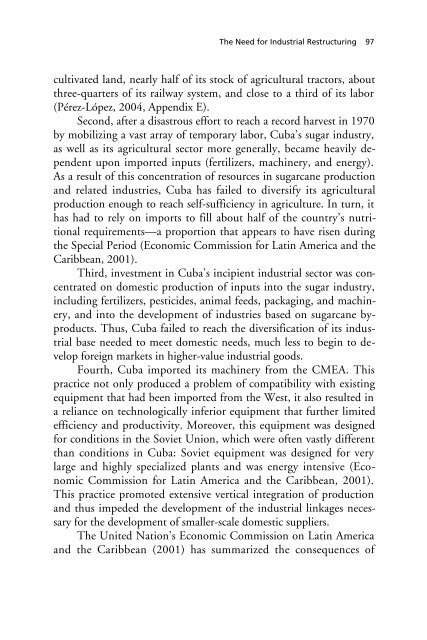Cuba After Castro - RAND Corporation
Cuba After Castro - RAND Corporation
Cuba After Castro - RAND Corporation
You also want an ePaper? Increase the reach of your titles
YUMPU automatically turns print PDFs into web optimized ePapers that Google loves.
The Need for Industrial Restructuring 97<br />
cultivated land, nearly half of its stock of agricultural tractors, about<br />
three-quarters of its railway system, and close to a third of its labor<br />
(Pérez-López, 2004, Appendix E).<br />
Second, after a disastrous effort to reach a record harvest in 1970<br />
by mobilizing a vast array of temporary labor, <strong>Cuba</strong>’s sugar industry,<br />
as well as its agricultural sector more generally, became heavily dependent<br />
upon imported inputs (fertilizers, machinery, and energy).<br />
As a result of this concentration of resources in sugarcane production<br />
and related industries, <strong>Cuba</strong> has failed to diversify its agricultural<br />
production enough to reach self-sufficiency in agriculture. In turn, it<br />
has had to rely on imports to fill about half of the country’s nutritional<br />
requirements—a proportion that appears to have risen during<br />
the Special Period (Economic Commission for Latin America and the<br />
Caribbean, 2001).<br />
Third, investment in <strong>Cuba</strong>’s incipient industrial sector was concentrated<br />
on domestic production of inputs into the sugar industry,<br />
including fertilizers, pesticides, animal feeds, packaging, and machinery,<br />
and into the development of industries based on sugarcane byproducts.<br />
Thus, <strong>Cuba</strong> failed to reach the diversification of its industrial<br />
base needed to meet domestic needs, much less to begin to develop<br />
foreign markets in higher-value industrial goods.<br />
Fourth, <strong>Cuba</strong> imported its machinery from the CMEA. This<br />
practice not only produced a problem of compatibility with existing<br />
equipment that had been imported from the West, it also resulted in<br />
a reliance on technologically inferior equipment that further limited<br />
efficiency and productivity. Moreover, this equipment was designed<br />
for conditions in the Soviet Union, which were often vastly different<br />
than conditions in <strong>Cuba</strong>: Soviet equipment was designed for very<br />
large and highly specialized plants and was energy intensive (Economic<br />
Commission for Latin America and the Caribbean, 2001).<br />
This practice promoted extensive vertical integration of production<br />
and thus impeded the development of the industrial linkages necessary<br />
for the development of smaller-scale domestic suppliers.<br />
The United Nation’s Economic Commission on Latin America<br />
and the Caribbean (2001) has summarized the consequences of

















